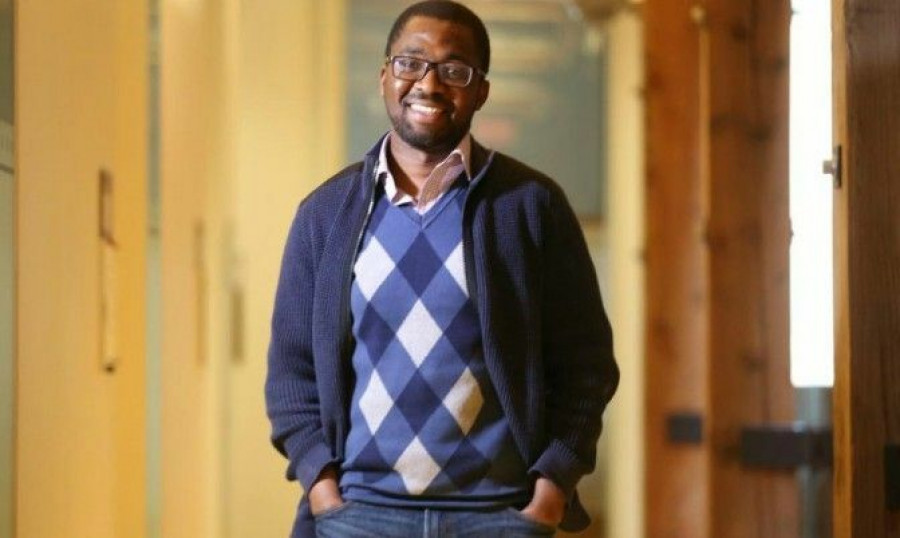He’d been placed in the math stream based on an admission exam that determined aptitude. But among the almost 45 students, there were only four or five girls. The next year, that number dropped to two.
It didn’t make any sense, Mourifié thought. Math isn’t an innate skill; there shouldn’t be such a dramatic gender disparity.
Fast-forward almost two decades and Mourifié is now an assistant professor of economics at the University of Toronto. He teaches courses in applied econometrics and quantitative methods but his passion, and a big part of his research, is grounded in his memories from the classrooms of West Africa.
He is driven to understand why there aren’t more women that pursue studies, particularly math, that lead to STEM (science, technology, engineering and mathematics) jobs and how that imbalance can be corrected.
In 1987, 20 per cent of people working in STEM-related jobs in Canada were women. That number has grown to only 22 per cent today. Again, to Mourifié, it was perplexing. And where it becomes particularly significant is that those STEM jobs are typically among the highest-paid professions. So getting more women to study math, the discipline at the core of many STEM jobs, could significantly narrow or close the overall gender wage gap.
“The dream is to have some impact on the future and have more girls passionate about STEM and having more choice (of careers) in STEM,” says Mourifié. “The ultimate goal is the reduction of inequality between men and women.”
Mourifié’s studies earned the 32-year-old one of the 2017 Polanyi Prizes. The $20,000 award — named for U of T professor John Polanyi, recipient of the 1986 Nobel Prize in Chemistry — is awarded annually by the Ontario government to five young researchers doing exceptional work in the fields of chemistry, physics, physiology/medicine, literature and, Mourifié’s discipline, economic science.
Mourifié’s findings were deemed significant enough that he was invited to Ottawa in February to be part of a four-person panel presenting to a Senate group on Women and Girls in STEM.
One of the enduring theories about why women avoid STEM jobs is based on financial concerns. Women working in STEM often end up in lower-paying technical jobs as opposed to professional roles and earn only 82 per cent of what men do. So women, fearing both wage discrimination and a glass ceiling in STEM workplaces dominated by men, opt to pursue other career paths.
But Mourifié, through his research, concludes there are significant non-pecuniary reasons for the disparity.
Mourifié asserts that many girls develop what he calls “mathemaphobia” and avoid math as they progress through school. That, he proposes, is at the root of the gender disparity in STEM jobs.
He believes that anxiety must be addressed in the early years of primary school before girls begin rejecting math as a viable option and thereby shut themselves out of future opportunities in STEM fields. His Ottawa presentation included research that suggests by Grade 2 both boys and girls have already begun to associate math with males.
That socialization causes many girls to grow up believing that the only jobs in STEM for them are in less math-intensive areas such as in life sciences or psychology.
“What is not fine to me is when a kid, because of stereotyping at an early age, ends up at high school and has already completely closed some doors,” says Mourifié.
Mourifié told the Ottawa gathering that 84 per cent of Canadian elementary school teachers are female — a number supported by Statistics Canada in 2011 — and, often, they have not graduated university in math fields. He cited a study that concluded math-anxious female elementary teachers impair the math achievement of female students.
While Mourifié says laws and policies aimed at ensuring fair hiring practices and equal wages are important, he believes the government should serve future generations by investing in those primary school educators, providing professional development that makes them more comfortable teaching math. That would help fight against the masculine view of math and give those students female role models who they would see as versed in the subject, and at ease.
Jennifer Flanagan is the co-founder and CEO of Actua, a charitable body that engages Canadian youth in STEM education. While she takes issue with putting the onus on female elementary teachers since that “argument is placing the blame on women,” she says her organization agrees that a greater investment must be made in teaching STEM in the early grades.
“There needs to be more of an emphasis placed on strengthening our teachers’ ability to teach science in elementary schools across the board,” she says. “The best way to do that is when they are being trained initially. That’s a major area needing additional investment … (or) this problem will become amplified as technology becomes more pervasive.”
Flanagan says that “when girls are young, there is absolutely no difference (compared to boys) in their enthusiasm, excitement, interest and confidence in science and technology.”
But as they grow, they receive messages about “who does science, who does technology and who’s good at it and what careers are appropriate for them in the future.”
That gender stereotyping even comes from parents who, for example, are far more likely to put their boys in extracurricular computer science or technology programs.
“The message overall is these are still fields dominated by men, more suited towards men,” says Flanagan.
Marc Henry, Mourifié’s principal PhD adviser at the University of Montreal, says it’s “very early days” when it comes to assessing whether his former student’s research might help bring change.
“I certainly hope so,” says Henry, now graduate program director in the department of economics at Penn State University.
“I think the focus on very early childhood investments is crucial. That is something that a lot of bright minds are now turning to, not specifically on women’s mathematics education but education in general.”
Mourifié’s underlying interest in this research is grounded in his own experience. He understands what it means to have doors closed along life’s path.
Had Mourifié had his way and followed his passion, he’d now be working in medicine rather than teaching economics.
In 2002-03, while studying math like his two older brothers, Mourifié was considering what to do after his final high school year in Abidjan, the largest city and economic centre of Ivory Coast. Suddenly the options were removed.
Rebel soldiers took up arms against the government, sparking a civil war and fracturing the country. Mourifié and his family — his father is an agricultural engineer and his mother an elementary school teacher (who didn’t teach math) — decided it was best for the 16-year-old to leave. He had a scholarship offer to study mathematics, at a university in Morocco. That wasn’t his dream but it was his opportunity to flee violent circumstances and ensure a higher education.
“Sometimes a situation happens (so) the decision you make is not necessarily the optimal decision for you,” he says. “If I was (in Canada), I’m pretty sure I would have pursued medical science. But I did not do this because I was constrained in my choices.”
In Fez, once enrolled at Sidi Mohamed Ben Abdellah University, he became further convinced that the pursuit of math was not for him and after one year tried to transfer into medicine. He was denied.
Mourifié completed his undergrad studies and then did a master’s degree in statistics. A professor in Morocco, who had studied at McGill University, recognized his ability as a researcher and urged the student to pursue his doctorate. He suggested the Montreal school.
Mourifié went on McGill’s website and immediately had doubts; he had clicked on the English version. He grew up speaking French and the only English he knew was from a one-hour class, once a week.
So he looked, instead, at the Université de Montréal. Not only did its website come up in French but the pictures seemed to include more Black faces like his own.
“I thought maybe they’d be more willing to accept me,” he says.
Mourifié applied. A month later he received an email saying he’d received a scholarship. So at 22, in 2008, he went off to Montreal to do a PhD in economics.
He says he learned English “on the fly” and was helped when he did a one-month immersion with a family in Scarborough, a year into his studies.
When he was recruited to come to U of T to take an assistant professor position in 2013, he says his English was only “so-so” but the university “paid more attention to my knowledge than my ability to speak enough English.”
Mourifié says it helped that the first course he taught was quantitative economics, which is mostly statistics.
This wasn’t the life he envisioned but Mourifié says he is happy and “deeply embedded” in his research. He is now married — his wife, Hajara, also from Ivory Coast, is an elementary school teacher in French immersion — and has a 2-year-old son.

“I didn’t get to do what I really wanted to do but I cannot complain now because I really like what I’m doing,” says Mourifié.
Dwayne Benjamin, who was the associate chair in U of T’s economics department when Mourifié was hired, says much of the research done by econometricians like Mourifié “can be dry,” but this particular study “has hit it out of the park in terms of people being interested.”
Benjamin says he’s not surprised given the young professor’s passion.
“He’s at the extreme of really caring about what he’s doing in terms of the substance of the economics and the substance of the bigger, important social questions. That’s rare with an econometrician,” says Benjamin.
Flanagan, from Actua, says there is “no silver bullet” that will correct the gender imbalance in STEM but it is good that researchers such as Mourifié are bringing the issue more attention.
She was also heartened by the recent science-friendly federal budget that proposed investing heavily in technology and research. It also mentioned improving the situation for women in those fields while striving for more diversity in the science community “including increasing the number of women who are nominated for Canada Research Chairs.”
Mourifié says he hopes in the future to apply his research methods to examine financial challenges facing minorities. He has also been involved in a project in Nova Scotia that is attempting to provide Indigenous youth with more opportunities in technology.
Mourifié says the Polanyi Prize is important to him, not for the money but more because it’s a reassurance that the research he is doing is valued.
“When I got this scholarship to come to Canada, I was very surprised and very happy they gave me this opportunity to come from nothing with just my grades,” he says.
“I always thought that I owed something to Canada. So when I received the prize, I was happy that Canada recognized that maybe I’m doing something that may help. So, to me, I’m paying back. I was very happy feeling this.”
This article was republished with permission and originally appeared in The Toronto Star, with photos by Vince Talotta.

 By Paul Hunter
By Paul Hunter 








